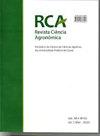利用巴西大豆产区估计育种值进行杂交性能预测
IF 0.7
4区 农林科学
Q3 AGRICULTURE, MULTIDISCIPLINARY
引用次数: 0
摘要
-本研究的目的是通过对一组常规大豆基因型的杂交性能预测,获得育种价值(BV),并在不同季节和环境的实验测试中,评估该方法所产生的后代的预测与实际生产潜力之间的相关性。并确定该方法在巴西大豆大区(SMR)和土壤与气候区(SCR)的高产潜力子代培养中是否有效。选择481个传统优良基因型作为亲本,生成BV,并采用限制性最大似然/最佳线性无偏预测混合模型(REML/BLUP)进行杂交预测。2019年,f1和f2分离群体的预测杂交和进步被携带并发送给Passo Fundo-RS、camb本文章由计算机程序翻译,如有差异,请以英文原文为准。
Performance prediction of crosses using estimated breeding values for regions of soybean production in Brazil
- The aim of this study was use the performance prediction of crosses in a group of conventional soybean genotypes to obtain the breeding value (BV), and to evaluate the correlation between the prediction and the actual productive potential of the progeny generated by this method in experimental tests for different seasons and environments, and determine whether the methodology is efficient in generating progeny of high productive potential for the soybean macro-regions (SMR) and soil and climate regions (SCR) of Brazil. A total of 481 conventional elite genotypes were selected as parents, the BV were generated, and crosses were predicted using the restricted maximum likelihood/best linear unbiased prediction mixed-model procedure (REML/BLUP). In 2019, the predicted crosses and advancement of the F 1 and F 2 segregating populations were carried and sent to the breeding programs of a private company in Passo Fundo-RS, Cambé-PR, Rio Verde-GO, Lucas do Rio Verde-MT and Porto Nacional-TO, where they were sown during the 2019/2020 crop season. During the 2020/2021 season, 1868 progeny were selected and tested in experimental trials at these locations. The progeny were again tested during the 2021/2022 season in experimental trials in 50 environments in SCR throughout Brazil. The result of the analysis showed a very weak to moderate correlation, indicating little efficiency for the prediction model used in this study. It is suggested that the prediction model be revised to include a greater number of variables, such as the kinship matrix, so that the BV of the genotypes can be more assertively estimated, especially when the aim is to select progeny in early generations with a high degree of heterozygosity
求助全文
通过发布文献求助,成功后即可免费获取论文全文。
去求助
来源期刊

Revista Ciencia Agronomica
Agricultural and Biological Sciences-Horticulture
CiteScore
2.00
自引率
0.00%
发文量
41
审稿时长
4-8 weeks
期刊介绍:
To publish technical-scientific articles and study cases (original projects) that are not submitted to other journals, involving new researches and technologies in fields related to Agrarian Sciences. Articles concerning routine analysis, preliminary studies, technical notes and those which merely report laboratorial analysis employing traditional methodology will not be accepted for publication. The Journal of Agronomical Science also has the mission to promote the exchange of experience in the referred fields.
 求助内容:
求助内容: 应助结果提醒方式:
应助结果提醒方式:


